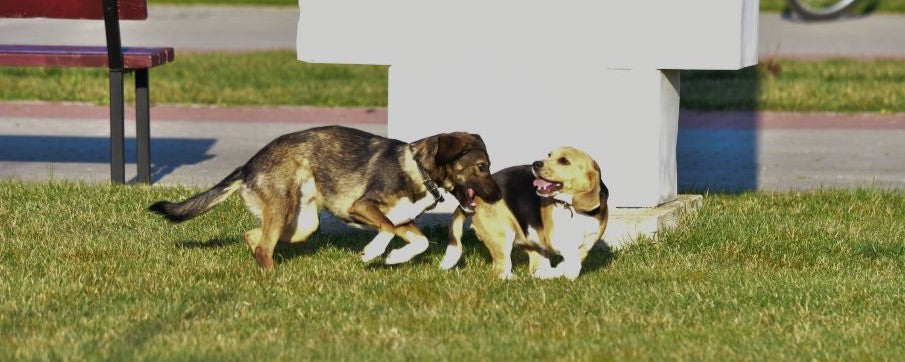
The Physical & Behavioural Characteristics of Dogs: Breed Specific Guide
Share
Dogs are wonderful pets and brilliant companions. It is easy to see why they are known as “man's best friend.” With more and more breeds of dogs now being chosen as pets, it is important to understand how each breed differs. We all have different lifestyles, and deciding the best breed to fit with our lifestyle, will lead to happy dogs and happy humans! Have a good think about what you want from your dog. Do you love nothing more than tramping for miles across the countryside? Or do you want a dog who will cuddle up on the sofa with you and enjoy having a belly scratch? Understanding more about the unique characteristics and traits of dogs will help you decide on the best dog for you and your family.
Physical Characteristics
Whilst you shouldn't decide a dog purely on how it looks, we all have preferences towards certain types or stamps of dogs. Consider the size of the dog to begin with. Do you have the space for a large dog? Is your car big enough? Is your house big enough? A giant dog such as a Newfoundland will take up a lot of space, and if your home is small, you may be better off with a smaller dog such as a Poodle. Dogs like people come in all shapes, sizes, and colours, and some breeds have different sizes within their breed. But it is worth noting that the breed characteristics can vary across the size, depending on how they have been bred.
- Labrador Retriever – a classic dog, the Labrador is a medium to large dog and comes in yellow, brown, black, or fox-red. They have a short, dense coat, and a broad skull, with attractive eyes.
- Cocker Spaniel – the Cocker Spaniel comes in two distinctive types, a Working Cocker, and a Show Cocker. The Working Cocker is slighter and finer than its stockier counterpart. They have long ears and come in a wide variety of colours, including black, red, golden, liver, black and tan, and liver and tan. The Kennel Club breed standards state that only a small amount of white is allowed on the chest.
- French Bulldog – commonly known as a “Frenchie” A French Bulldog is a small, compact dog with their trademark short, pointy ears, and short nose with wrinkles. French Bulldogs are a classic example of a brachycephalic breed, which is the veterinary term for their short nose.
- Bulldog – the larger relative of the French Bulldog, the Bulldog is renowned for its wrinkly skin and thickset stance, they are instantly recognisable.
- Golden Retriever – similar stamp to the Labrador, the Golden Retriever is a long-haired version.
- German Shepherd—traditionally used as guard dogs, the German Shepherd is a well-built dog with a dense coat and erect ears. Generally, they have black and brown/tan coats.
- Staffordshire Bull Terrier – affectionately known as the Staffy, a Staffordshire Bull Terrier is a solid and compact dog, which comes in a multitude of colours, from the classic brindle to the attractive silver or grey.
Behavioural Characteristics
While you may love the look of certain dog breeds, it is more important to choose a dog based on its behavioural characteristics and qualities than simply its looks. However, bear in mind that a dog's traits are just that, and each individual dog will vary depending on their personality, start in life, and how much training you put in. A high prey drive dog can still be taught to recall, it may just require more perseverance than one with a low prey drive.
- Labrador Retriever—extremely loyal and affectionate, the Labrador can be hard work till about 2 years, when they generally settle into excellent companionable family dogs.
- Cocker Spaniel—the two distinctive types of Cocker have different temperaments. Working Cockers, as per the name, are working dogs and are high-energy and extremely intelligent. The show cockers, which are bred for the show ring, are more placid, lower energy, and more inclined to cuddle on the sofa! Make sure you know which type you are looking at when choosing a puppy or rescue dog.
- French Bulldog—happy to just potter around the block, the Frenchie is a friendly, amiable-natured companion. They can struggle with high levels of physical exertion and heat due to being a brachycephalic breed of dog, so if you want a dog to come mountain biking with you, then they are probably not the best choice!
- Bulldog—gentle and loyal, the Bulldog is also happy to mooch around with you. Again, they can suffer from breathing issues due to their short noses and can be prone to weight gain, which puts pressure on their joints.
- Golden Retriever—joyful, gentle, and eager-to-please, the Golden Retriever makes an ideal family dog. They do like a good walk and love water, so be prepared for muddy mayhem!
- German Shepherd—as a working dog, the German Shepherd requires a job to keep them mentally engaged. Without this, they can become destructive and wilful. If they are kept sufficiently entertained, they make fantastic, courageous, and loyal dogs.
- Staffordshire Bull Terrier – very friendly and affectionate, the Staffy is excellent with people and makes a great family dog. They can be aggressive with other dogs, so be sure to spend lots of time on socialisation when your Staffy is a puppy.
Health Characteristics
A healthy dog is a happy dog. Some dogs are poorly bred, by breeders who are only interested in their financial gain, rather than the future life of the dog and the breed. If you are looking at a brachycephalic breed, study the length of the nose. The longer, the better for health. Similarly, dachshunds with their cartoon-like long bodies can be prone to back problems, but some will have shorter backs than others. If you are buying a puppy, make sure you examine the mother. Does she look proportional? Does she seem healthy? If you are buying a Labrador puppy, then ask to see the parents' hip scores. Labradors as a breed can be prone to hip dysplasia, which is a heredity disease. Buying a puppy from parents with a good hip score means that your dog is less likely to be affected by hip dysplasia.
You will know your dog, and you will know when their behaviour seems out of character. If they are unusually lethargic, then this can because for concern. Whilst dogs will sometimes have diarrhoea or vomiting, if it is prolonged then it is advisable to seek veterinary advice. Repeated scratching can be a sign of discomfort, or irritation. Spaniels are prone to ear problems, which can present as repeatedly scratching their ears, or shaking their heads. As with all health, it is important to look for changes in their behaviour, which may be an indicator of pain or distress. It is always sensible to seek veterinary advice if you are worried about your dog.
Dog Breeds and Their Unique Characteristics

- Labrador Retriever – a picture-perfect family dog, ready for long country walks, and happy evenings snoring by the fire.
- Cocker Spaniel – whether you want an energetic working companion, happy to be out in the field all day, or a cuddly and loyal companion to enjoy afternoon films with, a Spaniel is a great choice of dog.
- French Bulldog – enjoy trips to the park with your Frenchie, and fun family times playing in the garden.
- Bulldog – be prepared to be stopped in the street for people to talk to you! The Bulldog is an iconic British dog and will make an amazing companion.
- Golden Retriever – a beautiful family dog, who loves a walk that includes water. Be prepared for being loved by a water-soaked ball of affection!
- German Shepherd – regal and proud, the German Shepherd loves nothing more than doing a job. Keep him engaged, and he will be your loyal companion.
- Staffordshire Bull Terrier – entertain your family with the antics of your Staffy. Enjoy walks, playtimes, and cuddles!
Relationships with Humans
As the joke goes: dogs are descended from wolves, but then they discovered we have sofas! Dogs have been man's loyal companion for 30,000 years. The dog was the first animal that we domesticated, thousands of years before we harnessed the power of the horse. Our relationship with dogs is enduring. Dogs are not only loyal, life-enhancing pets but are also used for crucial work. Dogs are used to detect drugs and bombs. They locate missing people, they can rescue people in the sea and mountains. They can lead the blind, and help the deaf. Likewise, they can guard and defend. Furthermore, they can hunt and capture criminals. Dogs are incredible. They are endlessly forgiving. Rescue dogs that have had incredibly difficult starts in life can turn into placid, lifelong friends. A dog's capacity to love is immeasurable. Our relationships with our dogs are incredibly important, they provide unconditional companionship. Therapy dogs are proven to reduce stress and anxiety, and are now taken into care homes, and hospitals to cheer the ill and the elderly. Our relationship with dogs is deep-rooted in our psyche and, like our ancestors before us, our dogs bring us great comfort and companionship throughout our lives.
Dog Breed Characteristics Conclusion
If you are looking for a dog as a pet, then be very realistic about your lifestyle and your personality. Don't get a high-energy dog if you like lying on the sofa, in the hope that it will encourage you to walk more – it won't. If you don't like drool, then don't get a Newfoundland. If you don't like mess, don't get a dog that sheds, or has a long coat that will attract mud. If you have a noisy, hectic family, don't get a nervous, timid dog. Choose a dog that matches you. There are many fun dog breed quizzes available online. Don't take them too seriously, but they can give you a good indicator of what breeds might suit you, or give you ideas about another breed that you may not have considered.
If you are looking at rescuing, bear in mind that you may need to put in extra effort with training, as you don't get to start with a blank slate, but first have to undo the damage done. Your dog will be part of your family for at least 10 years, so this is not a light-hearted decision to make. Do your research into your preferred dog breed, and if possible try to meet some. Though a dog may sound right on paper, you may not actually like it in real life, though bear in mind that dogs are very influenced by how well they are trained. If you walk with a friend who has an incredibly well-trained Vizsla, then you may think they are all like that. You won't see the hours of training and patience that they have put into their dog. An untrained high-energy dog is a liability, so be realistic about how much time you have. Choose wisely, and you will have a loving, fun companion that will bring you years of pleasure.
Keep your dog safe and secure with a custom-made dog kennel from the team at Dog Kennels Direct.
Read related article:



